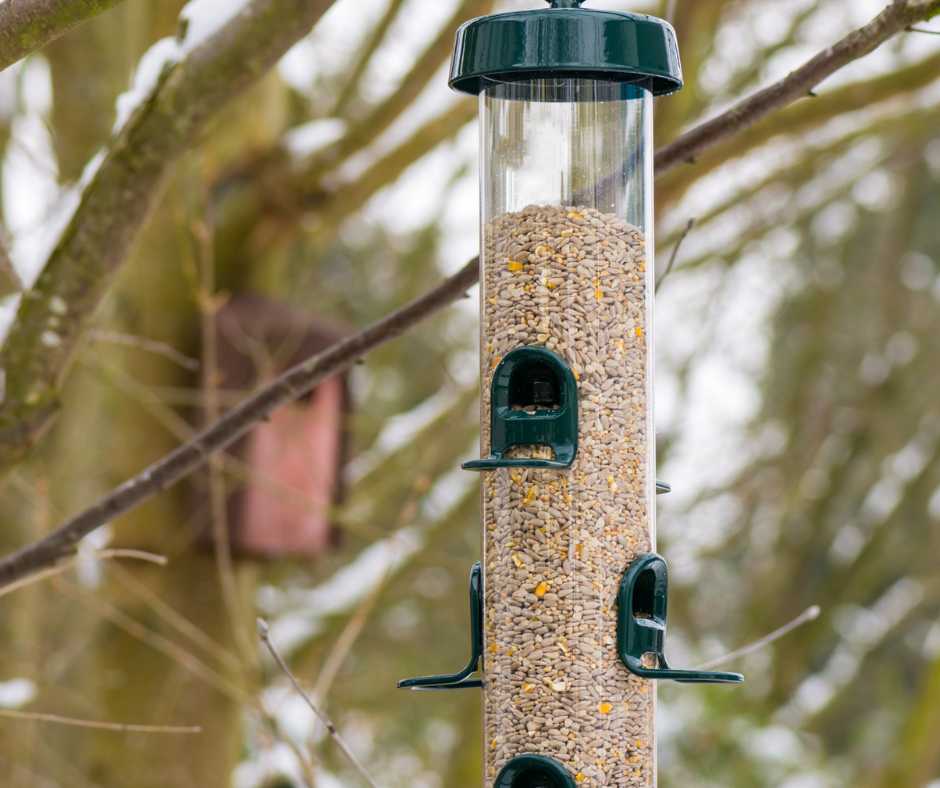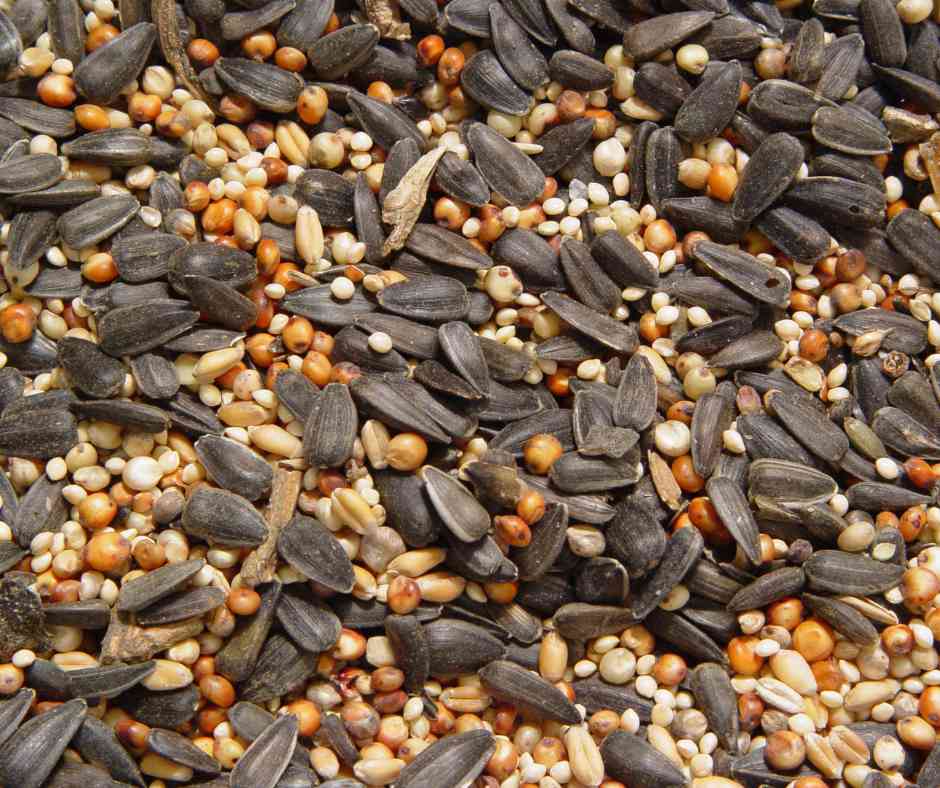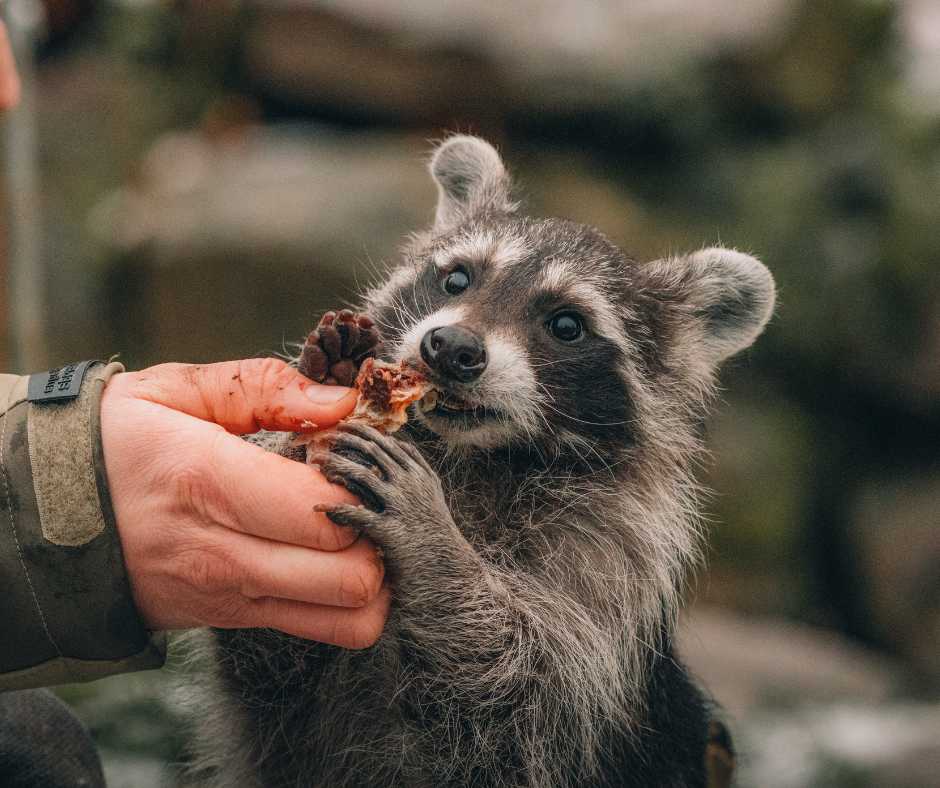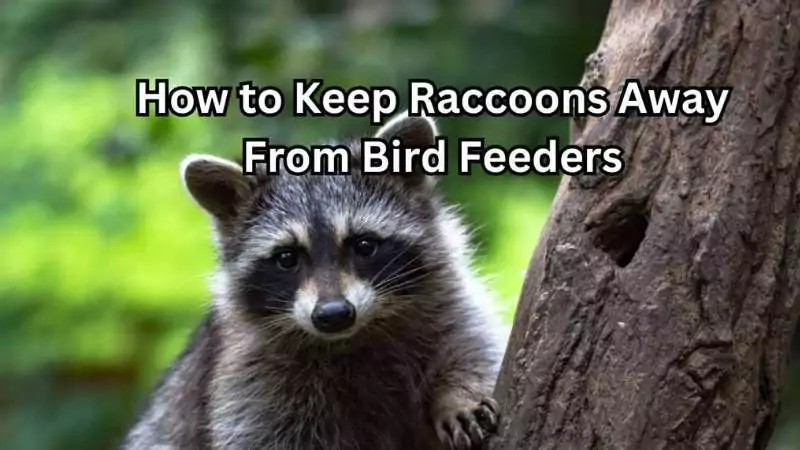Have you ever wondered why those clever raccoons can’t resist your bird feeders? Keeping these furry bandits away might be simpler than you think! We’re about to dive into a strategic guide on how to keep raccoons away from bird feeders.
Imagine setting up a chessboard in your garden, where every move is a step towards outsmarting these nocturnal visitors.
From smartly placing your bird feeders to using baffles and capsaicin-infused bird foods, we have all the tactics lined up. Expect to learn about different feeder designs that raccoons can’t outsmart and how a clean feeding area can be your secret weapon.
Let’s roll up our sleeves and turn your bird haven into a no-raccoon zone, keeping your feathered friends happy and those crafty raccoons at bay. Get ready for some practical, easy-to-implement tips to transform your birdwatching experience!
The Essential Steps to Protect Your Bird Feeders
To keep raccoons away from bird feeders, follow these steps:
1) Feeders should be placed 10 feet from trees or structures.
2) Using baffles like stovepipe or dome types.
3) Adding capsaicin to bird food.
4) Choosing weight-sensitive or caged feeders.
5) Regularly clean the area and use no-mess bird seed.
6) Offering raccoons alternative food sources.
7) Consider humane trapping, if necessary, following local laws.
We’ll explore each method, ensuring your feathered friends dine peacefully while those furry bandits are left scratching their heads. Let’s roll up our sleeves and dive in!
Step 1: Optimal Placement of Bird Feeders
So, where do you place a bird feeder to keep those pesky raccoons at bay? It’s all about location! Just like you wouldn’t pitch a tent right next to a bear’s cave when camping, you want to avoid placing your bird feeder exactly where raccoons can quickly reach it.
Let’s think like a raccoon for a second. These critters are natural climbers – trees are like their ladders! If your feeder is near a tree, deck, or fence, it’s like inviting a raccoon for a free buffet.
The trick is to place your feeders in open spaces, far from these ‘launchpads’ that raccoons use to jump or climb onto them. You want to make it as tricky as possible for these masked bandits to reach the feast.
Now, remember the Goldilocks rule – not too close, not too far. You want the feeder close enough to enjoy the view of your feathered friends but far enough that a raccoon can’t make a leap of faith and land right on it. About 10 feet away from potential raccoon springboards should do the trick.
It’s also a smart move to avoid low-hanging branches. Raccoons are like acrobats of the animal kingdom; if they can reach a branch, they’re halfway to your birdseed. Keeping feeders high enough (about 5-6 feet off the ground) and away from climbable structures can turn your bird feeding station into a no-raccoon zone.
By placing your feeders thoughtfully, you’re setting up the first line of defense in our raccoon-proofing game. It’s like playing chess with Mother Nature – and with these tips, you’re well on your way to saying “Checkmate!” to those furry little intruders.

Step 2: Implementing Effective Baffle Solutions
Ready to gear up your bird feeders with their very own superhero capes? Enter the world of baffles – the ultimate raccoon deterrents. These clever devices are designed to keep those climbing critters at bay, ensuring your bird feeders remain for the birds only.
To help you choose the best baffle for your setup, let’s compare the most popular types:
Baffle Comparison Table:
| Baffle Type | Appearance | Pros | Cons |
| Stovepipe | Cylindrical tube | Great for wrapping around poles, making it hard for raccoons to climb | Might require resizing to fit different pole diameters |
| Dome/Bowl | Upside-down bowl | Perfect for creating an overhang above feeders, blocking raccoon access | Not suitable for all feeder types, especially larger ones |
With the stovepipe baffle, imagine a raccoon trying to scale a greased carnival pole – it’s that slippery and challenging! Then, consider the dome or bowl baffle, acting like a protective umbrella over your feeder, telling raccoons to keep out.
Remember, correct installation is crucial. Pole baffles must be high enough to prevent raccoon leaps, and hanging baffles should be comprehensive to stop any sneaky reach-arounds. It’s all about creating a raccoon-proof fortress for your feathered guests.
By choosing and setting up the right baffle, you’re not just outsmarting raccoons but ensuring a safe bird dining space. So, select your baffle, install it carefully, and enjoy a raccoon-free birdwatching experience!
Step 3: Utilizing Capsaicin-Infused Bird Foods
Have you ever wondered if birds can handle the heat? Unlike us and our furry friends, birds are chilled with spicy stuff. That’s where capsaicin comes in – the same thing that gives chili peppers their kick. When added to bird food, it becomes a game-changer in our raccoon-proofing strategy.
So, how does it work? While raccoons have a taste sensitivity similar to ours, meaning they get the whole fire-alarm-in-the-mouth experience, birds don’t have the same receptors. So, they can happily munch on capsaicin-coated seeds without any bother. It’s like having a VIP food club exclusively for birds!
But here’s the cool part: you don’t have to be a kitchen wizard to whip up this special bird treat. You can find available capsaicin-infused bird foods – from suet cakes to seed mixes. It’s as easy as picking up your regular bird food with a spicy twist.
Now, you might be thinking, “Is this safe for the birds?” Absolutely! Our feathered friends won’t feel the heat. It’s been a proven method many bird enthusiasts use to keep raccoons puzzled and at bay. Plus, it’s a humane way to deter them. They’ll sniff or taste once, find it distasteful, and that’s it – they’ll look for dinner elsewhere.
Incorporating capsaicin into your bird feeding routine is like setting up an exclusive party for birds – one where raccoons aren’t on the guest list. So go ahead, spice things up a bit!

Step 4: Choosing Raccoon-Proof Bird Feeders
When safeguarding your bird’s buffet, selecting a suitable feeder is key. Imagine equipping your bird feeding station with the perfect defense against those crafty raccoons. Here are some top-notch raccoon-proof feeder options, each with its unique way of keeping those furry intruders at bay:
- Weight-Sensitive Feeders: These are the bouncers of the bird world. They’re smart enough to detect if someone too heavy (like a raccoon) is trying to get at the food. When they sense too much weight, they automatically shut down access. It’s like the feeder saying, “Nope, this party isn’t for you, Mr. Raccoon!”
- Caged Feeders: Think of these as exclusive bird clubs. They’re encased in a metal cage with openings suitable for birds but too small for raccoons and other larger animals. This design is a double win – it keeps out raccoons and discourages squirrels and larger birds that might dominate the feeder.
- Pole-Mounted with Baffles: These feeders are like fortresses. Mounted on a pole with a baffle system, they create an obstacle course that raccoons can’t navigate. Ensure the pole is smooth and tall, making it a challenge for even the most acrobatic raccoons.
Picking a suitable feeder keeps raccoons away and makes a safe place for birds to eat. Choose one that fits your garden best, and have fun watching birds without raccoons around!
Step 5: Maintaining a Clean Feeding Area
Keeping your bird feeding area clean is a great way to stop raccoons from coming around. It’s like being the best bird feeder cleaner, ensuring raccoons don’t want to snack there. Here’s a simple list to help you:
☐ Always clean up seeds and hulls that fall. It stops raccoons from being attracted to your feeder.
☐ Put seed catchers under your feeders. They’re like big mats that catch dropped seeds, so cleaning is easy, and raccoons find less to eat.
☐ Choose a birdseed that doesn’t make a mess. These seeds keep the area cleaner, so raccoons are less likely to visit.
By doing these things, you’re keeping the feeding spot looking good and making it less enjoyable for raccoons. This way, you can enjoy watching birds without raccoons bothering them.
You may also read: How to Clean Bird Feeder
Step 6: Alternative Feeding Options for Raccoons
So, you’ve got a soft spot for those mischievous raccoons but wish they wouldn’t turn your bird feeders into their snack bars? Here’s a nifty idea: why not just set up a separate dining spot for them? It’s like creating a VIP section in your backyard where they can feast without disturbing the birds.
Think of it as a peace offering – a little corner where you can leave treats specifically for raccoons. It could be anything from fruits to special raccoon snacks.
The key here is to place this raccoon diner away from your bird feeders, like putting the kids’ table at the other end of the garden during a family barbecue. You’re not just feeding them; you’re strategically distracting them.
Now, I know what you might think: “Am I inviting more raccoons into my yard?” The idea is more about managing the ones that already visit. By providing a separate feeding area, you reduce the chances of them tampering with your bird feeders. It’s like giving them a better option, so they leave your bird feeders alone.
Remember to keep this raccoon-friendly zone clean and monitor it regularly. The goal is harmonious coexistence – your feathered friends get to dine in peace, and the raccoons get their little banquet away from the bird party. It’s all about balance and kindness in our shared outdoor spaces.

Step 7: Considerations for Humane Trapping
If your other ways to keep raccoons away must be fixed, catching them gently can be your next step. But it’s a last choice, used only when needed. Always check the rules in your area about seeing and moving wildlife first. We want to ensure we’re doing everything correctly and following the law.
So, trapping is okay in your area. The next step is to get a trap that’s kind to our raccoon friends. We’re not talking about anything harsh – think of it more like a temporary holding room with some snacks.
You can bait the trap with something yummy, like fruits or marshmallows. Raccoons, being the curious creatures they are, will check it out, and, voila, they’re safely caught.
Now, after you’ve caught a raccoon, what’s next? It’s relocation time. But here’s the deal: you’ve got to release them in a suitable habitat, ideally a reasonable distance from residential areas.
This part is crucial because we’re not just moving our problem to someone else’s backyard. It’s about finding a balance between our needs and the well-being of these little bandits.
Always remember, humane trapping isn’t about punishment but finding a solution that works for everyone, raccoons included. It’s the wildlife version of a time-out, focusing on kindness and respect for our furry neighbors.
You may also read: How to Keep Raccoons Away from Bird Feeders
Understanding Raccoons: Behavior, Habits, and Deterrence
Keeping raccoons away from your bird feeders is like playing a game where you must think smart. Raccoons are clever and good at solving problems. They remember where they find food and mostly look for it at night. They can quickly get to your bird feeders because they eat many things and are good climbers.
To stop them, use smooth, tall poles that raccoons can’t climb for your feeders. You can also bring in your feeders at night or use lights that turn on when they detect motion. Putting up baffles or using unique feeders also helps make it hard for raccoons to reach the food.
The goal is to find ways to keep the raccoons away without hurting them so the birds and the raccoons can have their food in peace.

People Also Asked
What is the most effective way to keep raccoons away from bird feeders?
Combining several strategies, like using baffles, capsaicin-treated bird food, and proper feeder placement, is usually the most effective.
Is it safe to use capsaicin in bird feeders?
Yes, birds are not sensitive to capsaicin like mammals, so it’s a safe and effective way to deter raccoons.
Can raccoons damage bird feeders?
Absolutely. Raccoons are strong and clever and can break feeders while trying to access food.
Is it okay to feed raccoons separately to keep them away from bird feeders?
Yes, providing an alternative raccoon food source can help keep them away from your bird feeders.
Wrap Up
In our adventure to keep raccoons away from bird feeders, we’ve learned how to live together with nature. Bird watching is fun but also about being friends with nature. We use intelligent ideas like putting feeders in the right spots, using baffles, and giving raccoons their food.
This way, we care for the birds and all the animals in our yards. It’s not about tricking raccoons; it’s about sharing our space with them. Use these cool tips to have a great time watching birds and help make our backyards suitable for all animals.
Additional Sources –
National Wildlife Federation (NWF) – Coexisting with Raccoons
The Humane Society of the United States – Solving Problems with Raccoons

